Trellises and support structures in general
April 24, 2008
Marianne Mueller, mrm@sonic.net
I decided to focus only on trellises and support structures in the
garden, although garden structures include pavers, edging, stepping
stones inside beds, fences around the garden, benches, picnic table,
small table, birdbath, water basin for insects, containers like half
wine barrels, shed for tools, compost bins ...
Types of support structures include: Trellises, stakes, poles, arbors,
pyramids, teepees, cages, fences, walls, entrace gates and entrance
archways.
Trellises: Advantages
Vines that climb up and over a trellis are a beautiful way to frame or
accent a garden. They provide dimension and focus. Mixed
vegetable/ornamental gardens, sometimes called
edible landscapes, make use of support structures as design elements.
In addition to flowering vines like wisteria, nasturtium, climbing
rose and California grape, many vegetables benefit from support while
growing, including: peas, beans, squash, cucumber, tomatoes, peppers, gourds,
melon, berries, espaliered fruit trees and table and wine grapes.
Advantages:
-
Trellises provide support for vines
to climb and grow, which results in greater yield per square foot of
soil.
- Trellises are a great help for gardening in small spaces. If
you have only a small patch that gets great sun, choose vegetables
that grow well vertically.
- Trelissed plants produce for longer periods,
because more leaf area is exposed to sunlight.
- The fruit and
vegetables are easier to spot and pick when they are trellised.
- More
air circulation through trellised vines helps keep the plant healthy
and vigorous, and lifting the vines off the ground reduces problems
from pests, fungi and viruses.
They are not available to snails and slugs and are not
prone to ground rot.
- Vines spreading on a trellis provide shade for a
porch, patio or wall.
Trelisses: Possible disadvantage
The only slight disadvantage to trellising is that the plants are more
open to wind, so flowering plants - which includes all the vegetables
named above! - may have lower pollination rates. Some people
hand-pollinate squash. Remember there are male and
female flowers on squash, so you need to move the pollen from the
male flower onto the female flower.
Building support structures
There are both upfront and
ongoing tasks to creating a trellised vine. First, you need to either
build or buy the type of trellises you need - that will depend on what
sorts of plants you've decided to grow. Although you can buy
trellises from any garden store and many online catalogs, they are
often expensive. Construct your own from recycled materials!
Leftover pieces of 2"x4", 2"x2" and 1"x2" lumber are perfect, as are
sturdy wooden poles of any sort and wooden lattices. An old wooden
ladder makes an attractive tall trellis, and is sturdy enough for
larger, heavier vegetables. Heavy gauge wire, fine wire, wire mesh,
wire net, nylon net, bird netting and gardening twine can be used over
and over. Rebar poles, wooden stakes, bamboo poles and even 1" thick
and 8' long straight tree branches - if you're lucky enough to have
these left over from a pruning task! - are all great materials. If
possible, anchor corner posts 24" deep, so that the structure will be able
to support a large, heavy, productive set of plants. A cordless power
drill outfitted with a 12" drill bit is a great tool for boring a deep
hole in the ground. Six or seven bamboo poles that are 9' tall and 1" thick
can be wired together at the top, to form a simple pyramid. Pyramids,
tent-shaped structures, and the like, do not need to be firmly
situated in the ground, as the weight of the plants will not be
pulling the structure to one side, but will bear down upon the
structure.
Using support structures
Be sure to put the support structure in place at the same time that
you transplant or direct seed. If you push a structure into place
after the plant has started growing, you will damage its tender, young
roots. Also, remember to place support structures on the north side,
so that the bushy vines won't shade your other vegetables in
mid-summer.
The second task for creating and maintaining any support structure is
to keep an eye on whether or not you need to help a vine find or be
secured to a support structure. Some plants need more help climbing
up a trellis or fence. Wind sturdy vines through open sections in the
support structure, and anchor with gardening twine. Support heavy
fruits like squash, pumpkin and melon on shelving, in netting, or with
rags or old nylons. If left unsupported, their weight will drag the
vines down from the trellis. `
As vine crops reach the tops of their support structures, pinch off
the lead vine; the side shoots will take over the major growth and
food production.
Reports from Santa Clara County Master Gardeners - Research Trials
SCC MGs have conducted research trials to determine the best way to provide support to certain crops.
Beans
A 4' bamboo pyramid was not sufficient for the vigorous Asparagus
Bean. Three types of beans were planted around the pyramd but the
Asparagus Bean quickly swamped the others. Plant peas and beans
in double row, 6" apart, on either side of pyramid, V, tent-shaped or
any other support structure that will let vines grow up on more than
one side.
Berries
See the guidelines for
growing berries.
Cucumbers
Use a 4' tall square or pyramid structure. You will need to guide the cucumber vines and secure them with twine.
See the
report for the 1996 cucumber trial.
Melons and Gourds
As a general rule, any variety that produces fruit
smaller than a volleyball can be trellised. Vines will grow strong
enough to hold the weight of the fruit, so there's no need to support
fruits with individual hammocks, as is recommended for larger
vegetables. The Montagnard trellis (see photo below) is an iinteresting design. As the
young squash and melon plants below it continue to grow, their vines
will be trained onto the trellis. Once fruits begin to form, they
will be suspended from the trellis, making them easier to harvest and
protecting them from insects and disease.
Trellises are recommended for growing melons, rather than letting the
melons trail along the ground. Although production is less, it
is the most consistent in providing fruits on a regular basis. It is
highly recommended for gardeners with limited gardening space who
desire a consistent supply of fruit during the growing period.
See the 2006
Melon Methods Trial 2006 report for details on not only trellising, but other aspects of growing melons.
At PADG, four 6' poles placed at the corners of a 4' square, with 6" grid fastened on the top, worked well for growing gourds.
Although four edible gourds were planted around the structure, one of the gourds did take over and swamp the others.
Tomatoes
See the 2001
Tomato Staking Techniques Evaluation for a extensive comparison of different
ways to stake tomatoes, and recommendations for different styles of growing tomatoes.
PADG photos by Marianne Mueller; all other Images from images.google.com
Click on any photo to see a larger version.
PADG Photos
PADG stands for the Palo Alto Demonstration Garden that is one of the
public field projects of the Santa Clara County Master Gardener
Program, http://mastergardeners.org/scc.html
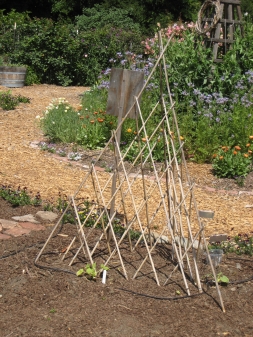 4' wooden pyramid, good for peppers (inside) and peas (either bush or climbing) or bush beans, planted in double row around the three bottom edges.
4' wooden pyramid, good for peppers (inside) and peas (either bush or climbing) or bush beans, planted in double row around the three bottom edges.
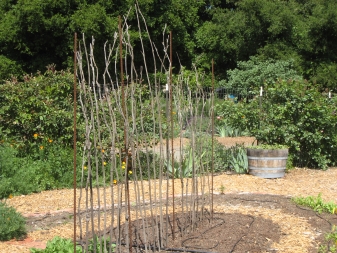 In the center of a vegetable bed, the master gardeners constructed a "wall" of 9' tall sturdy branches, with 4 or so tall rebar poles scattered among the branches. Strong wire runs horizontally every foot or so, connecting the vertical poles to make a grid. This works beautifully for beans. Experiment with planting several kinds of beans around one large structure - there won't be a problem with cross-pollination with beans, so it's OK to plant them in close proximity.
In the center of a vegetable bed, the master gardeners constructed a "wall" of 9' tall sturdy branches, with 4 or so tall rebar poles scattered among the branches. Strong wire runs horizontally every foot or so, connecting the vertical poles to make a grid. This works beautifully for beans. Experiment with planting several kinds of beans around one large structure - there won't be a problem with cross-pollination with beans, so it's OK to plant them in close proximity.
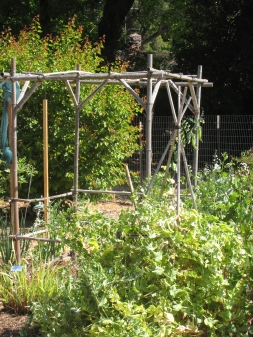 8' x 5' x 4' wooden rectangular structure built by the master gardeners. Note the use of supporting short pieces of wood that connect the corner poles with the poles that lie along the top. We grew cucumbers around this; cucumbers need ongoing help in climbing the structure.
8' x 5' x 4' wooden rectangular structure built by the master gardeners. Note the use of supporting short pieces of wood that connect the corner poles with the poles that lie along the top. We grew cucumbers around this; cucumbers need ongoing help in climbing the structure.
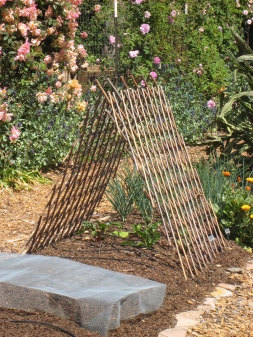 4' "V" or tent-shaped structure. Excellent for peas; plant a double row along each of the two bottom edges. (Perhaps fewer on the inside, as those plants will have less room to send out tendrils and leaves.)
4' "V" or tent-shaped structure. Excellent for peas; plant a double row along each of the two bottom edges. (Perhaps fewer on the inside, as those plants will have less room to send out tendrils and leaves.)
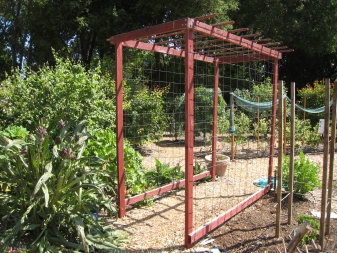 VERY sturdy 10' x 10' x 3' rectangular arbor. Strong heavy gauge wire runs up and down, and from side to side, to create a grid. We grew 3 or 4 varieties of beans up this last summer.
VERY sturdy 10' x 10' x 3' rectangular arbor. Strong heavy gauge wire runs up and down, and from side to side, to create a grid. We grew 3 or 4 varieties of beans up this last summer.
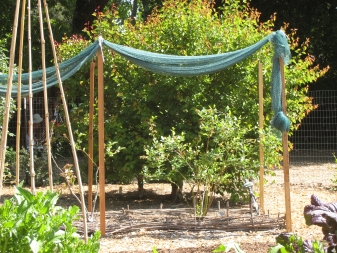 We have 5
blueberry bushes, which produce a fabulous amount of delicious
blueberries! The birds agree! We built a 8' high structure - poles
sunk 24" deep, and a strong wire stretched between poles. A cordless
power drill with a 12" drill bit is a great tool for boring a nice,
deep hole to sink the corner poles into. Bird netting is stretched
over the wire. The netting is easily lifted for harvest. And it
defeats the birds. to the left, you can see an 8' bamboo pyramid that
is ready for this summmer's beans in the Asian bed.
We have 5
blueberry bushes, which produce a fabulous amount of delicious
blueberries! The birds agree! We built a 8' high structure - poles
sunk 24" deep, and a strong wire stretched between poles. A cordless
power drill with a 12" drill bit is a great tool for boring a nice,
deep hole to sink the corner poles into. Bird netting is stretched
over the wire. The netting is easily lifted for harvest. And it
defeats the birds. to the left, you can see an 8' bamboo pyramid that
is ready for this summmer's beans in the Asian bed.
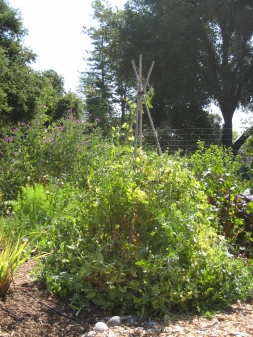 What a 5' pyramid of peas looks like towards the end of the (late winter/early spring) season. The peas form a huge bush. It helps to tie up the vines occasionally, to encourage them to grow vertically. Yield improves.
What a 5' pyramid of peas looks like towards the end of the (late winter/early spring) season. The peas form a huge bush. It helps to tie up the vines occasionally, to encourage them to grow vertically. Yield improves.
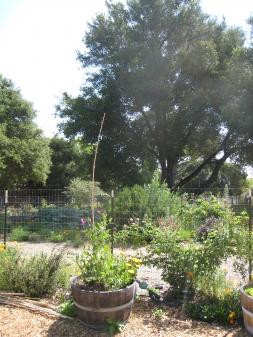 Not every structure is a handyman project! This container has a tall bamboo pole. I believe sweet peas will be staked up it.
Not every structure is a handyman project! This container has a tall bamboo pole. I believe sweet peas will be staked up it.
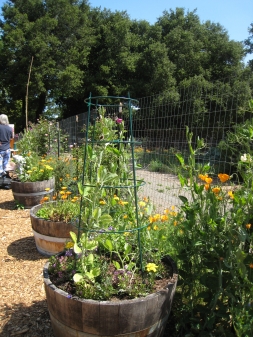 A simple, 4' tomato cage that would work well for a determinant tomato in a container. It looks like we have some sort of peas here now.
A simple, 4' tomato cage that would work well for a determinant tomato in a container. It looks like we have some sort of peas here now.
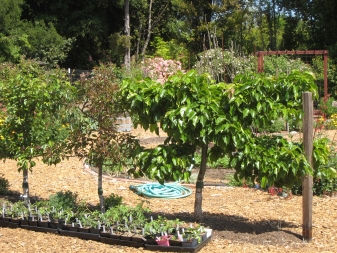 Espaliered fruit trees: Asian pear and several different apples. The plants on the ground are some ornamentals left over from the April 19, 2008 PADG Plant Sale. Anyone want
an Agave Americana ...?
Espaliered fruit trees: Asian pear and several different apples. The plants on the ground are some ornamentals left over from the April 19, 2008 PADG Plant Sale. Anyone want
an Agave Americana ...?
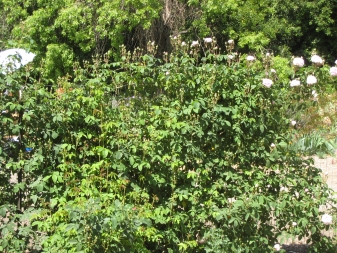 This climbing rose completely covers the wire mesh fence.
This climbing rose completely covers the wire mesh fence.
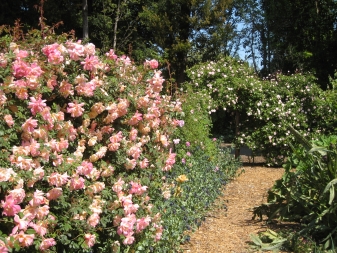 There are several different climbing roses and other flowering fines along the fenceline, leading down towards the rose-covered arched entrance.
There are several different climbing roses and other flowering fines along the fenceline, leading down towards the rose-covered arched entrance.
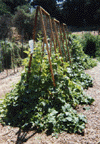 Cucumbers growing up a large "V" shaped trellis at a Santa Clara County Master Gardener garden.
Cucumbers growing up a large "V" shaped trellis at a Santa Clara County Master Gardener garden.
 The fabulous set of 3 nesting tomato cages, created by Santa Clara County Master Gardeners and sold for the low price of $37/set at the annual Spring Garden Market. These are the ideal tomato cages. Each is 6' tall and roughly 2 1/2' across. The wire mesh leaves a good 4" x 4" open space for easy harvest.
The fabulous set of 3 nesting tomato cages, created by Santa Clara County Master Gardeners and sold for the low price of $37/set at the annual Spring Garden Market. These are the ideal tomato cages. Each is 6' tall and roughly 2 1/2' across. The wire mesh leaves a good 4" x 4" open space for easy harvest.
The rest of the images are from images.google.com.
Note: there are only small versions of the following photos. Clicking on any of the photos will have no effect - there are no larger versions to look at.
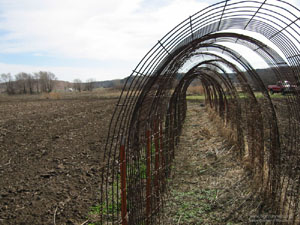 Arch; from hightunnels.org
Arch; from hightunnels.org
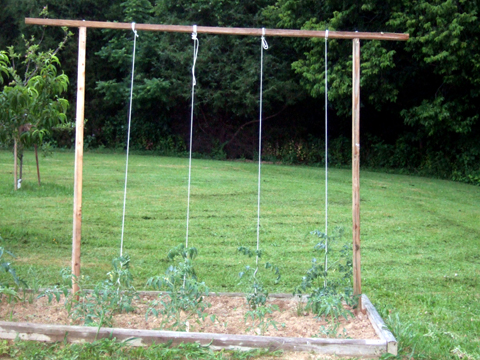 Use an old clothesline! From photobucket.com
Use an old clothesline! From photobucket.com
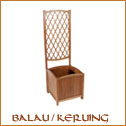 Some containers have built-in trellises; from dinephat.com
Some containers have built-in trellises; from dinephat.com
 An interesting tall trellis to put in a corner - it has a 90 degree bend. From gardentrellisesinc.com
An interesting tall trellis to put in a corner - it has a 90 degree bend. From gardentrellisesinc.com
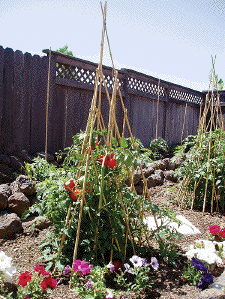 A criss-cross style of pre-made pyramid trellis. From gardeningwithease.com
A criss-cross style of pre-made pyramid trellis. From gardeningwithease.com
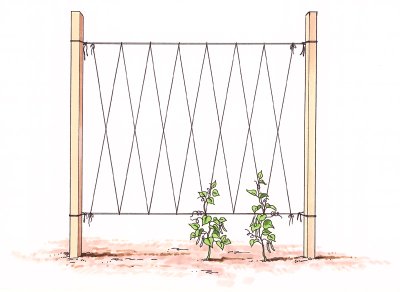 A "flat, along the wall" criss-cross trellis. From howstuffworks.com
A "flat, along the wall" criss-cross trellis. From howstuffworks.com
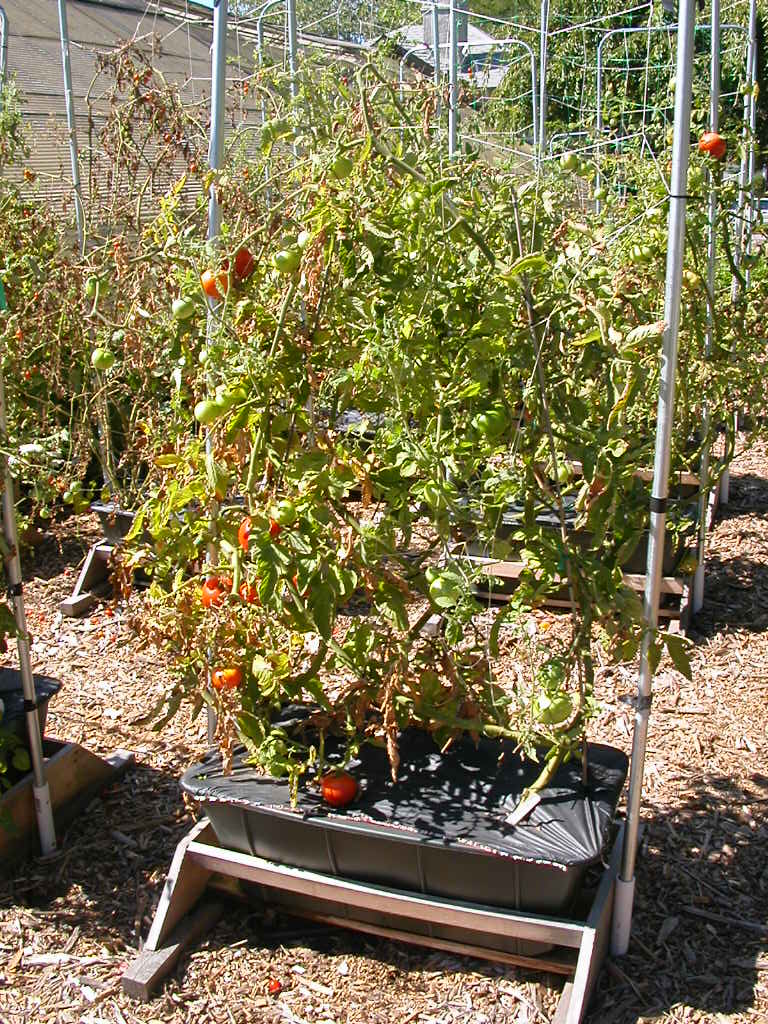 The pipe & net trellis that attaches to an EarthBox. This is what they sell, but you can easily construct your own. Necessary if you're growing tomatoes; might be needed for chile peppers, depending on the growth habit of the pepper plant.
The pipe & net trellis that attaches to an EarthBox. This is what they sell, but you can easily construct your own. Necessary if you're growing tomatoes; might be needed for chile peppers, depending on the growth habit of the pepper plant.
 A flat, tall trellis to set against a wall. From gardentrellisesinc.com
A flat, tall trellis to set against a wall. From gardentrellisesinc.com
 A ladder is a lot of fun, and super easy! Just put in place. Great for heavy vines. From gardeners.com
A ladder is a lot of fun, and super easy! Just put in place. Great for heavy vines. From gardeners.com
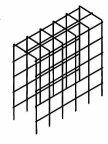 A tall arbor, suitable to place over a sunny pathway. From gardentrellisesinc.com
A tall arbor, suitable to place over a sunny pathway. From gardentrellisesinc.com
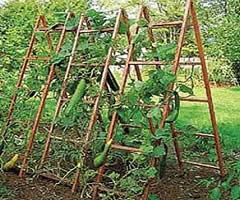 A simple "V" or tent-shaped trellis, great for peas, cucumbers, peppers. From gardentrellisesinc.com
A simple "V" or tent-shaped trellis, great for peas, cucumbers, peppers. From gardentrellisesinc.com
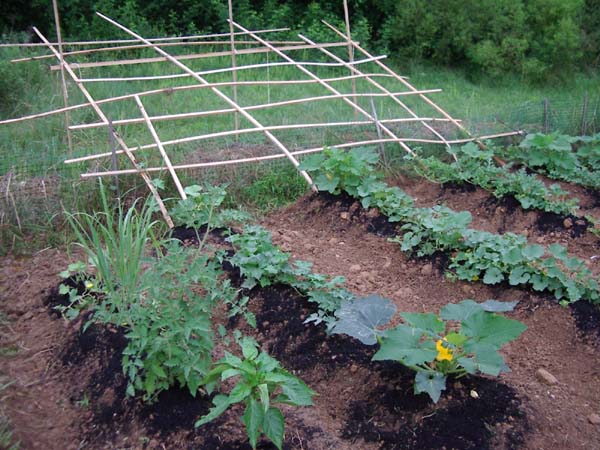 This Montagnard trellis is a special construction for heavier fruit like melon and large squash. The Montagnard trellis is an interesting design. As the
young squash and melon plants below it continue to grow, their vines
will be trained onto the trellis. Once fruits begin to form, they
will be suspended from the trellis, making them easier to harvest and
protecting them from insects and disease.
This Montagnard trellis is a special construction for heavier fruit like melon and large squash. The Montagnard trellis is an interesting design. As the
young squash and melon plants below it continue to grow, their vines
will be trained onto the trellis. Once fruits begin to form, they
will be suspended from the trellis, making them easier to harvest and
protecting them from insects and disease.
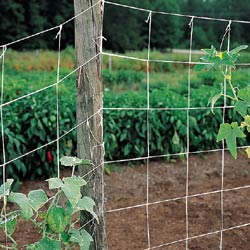 A simple trellis is made by stretching some sort of netting between posts. From jupiterimages.com
A simple trellis is made by stretching some sort of netting between posts. From jupiterimages.com
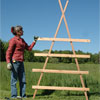 A simple, but very sturdy, flat triangular trellis, suitable for squash. From organicgardening.com
A simple, but very sturdy, flat triangular trellis, suitable for squash. From organicgardening.com
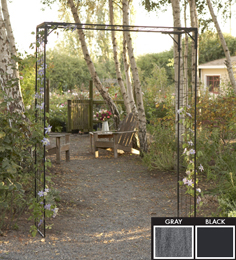 The premade structures from Smith & Hawken, like this rectangular arbor, are beautiful and have nice details, but they are pricey! From smithandhawken.com
The premade structures from Smith & Hawken, like this rectangular arbor, are beautiful and have nice details, but they are pricey! From smithandhawken.com
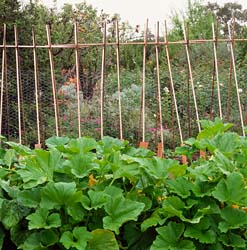 Here we see squash growing up a series of poles. From jupiterimages.com
Here we see squash growing up a series of poles. From jupiterimages.com
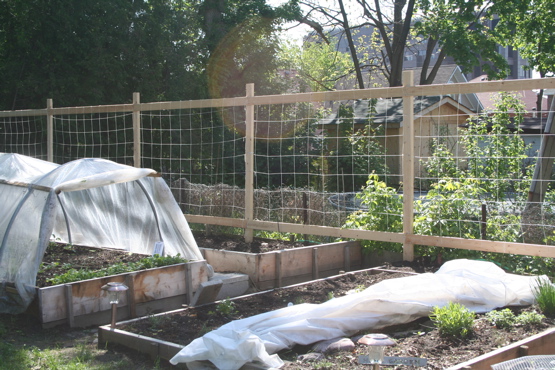 Remember that fencing around the garden can serve double duty and act as a support! Here we see heavy duty wire stretched between wooden poles.
Remember that fencing around the garden can serve double duty and act as a support! Here we see heavy duty wire stretched between wooden poles.
Marianne Mueller, mrm@sonic.net
Last modified: Thu Apr 24 18:18:09 PDT 2008
 Cucumbers growing up a large "V" shaped trellis at a Santa Clara County Master Gardener garden.
Cucumbers growing up a large "V" shaped trellis at a Santa Clara County Master Gardener garden.
 The fabulous set of 3 nesting tomato cages, created by Santa Clara County Master Gardeners and sold for the low price of $37/set at the annual Spring Garden Market. These are the ideal tomato cages. Each is 6' tall and roughly 2 1/2' across. The wire mesh leaves a good 4" x 4" open space for easy harvest.
The fabulous set of 3 nesting tomato cages, created by Santa Clara County Master Gardeners and sold for the low price of $37/set at the annual Spring Garden Market. These are the ideal tomato cages. Each is 6' tall and roughly 2 1/2' across. The wire mesh leaves a good 4" x 4" open space for easy harvest.
 Arch; from hightunnels.org
Arch; from hightunnels.org
 Use an old clothesline! From photobucket.com
Use an old clothesline! From photobucket.com
 Some containers have built-in trellises; from dinephat.com
Some containers have built-in trellises; from dinephat.com
 An interesting tall trellis to put in a corner - it has a 90 degree bend. From gardentrellisesinc.com
An interesting tall trellis to put in a corner - it has a 90 degree bend. From gardentrellisesinc.com
 A criss-cross style of pre-made pyramid trellis. From gardeningwithease.com
A criss-cross style of pre-made pyramid trellis. From gardeningwithease.com
 A "flat, along the wall" criss-cross trellis. From howstuffworks.com
A "flat, along the wall" criss-cross trellis. From howstuffworks.com
 The pipe & net trellis that attaches to an EarthBox. This is what they sell, but you can easily construct your own. Necessary if you're growing tomatoes; might be needed for chile peppers, depending on the growth habit of the pepper plant.
The pipe & net trellis that attaches to an EarthBox. This is what they sell, but you can easily construct your own. Necessary if you're growing tomatoes; might be needed for chile peppers, depending on the growth habit of the pepper plant.
 A flat, tall trellis to set against a wall. From gardentrellisesinc.com
A flat, tall trellis to set against a wall. From gardentrellisesinc.com
 A ladder is a lot of fun, and super easy! Just put in place. Great for heavy vines. From gardeners.com
A ladder is a lot of fun, and super easy! Just put in place. Great for heavy vines. From gardeners.com
 A tall arbor, suitable to place over a sunny pathway. From gardentrellisesinc.com
A tall arbor, suitable to place over a sunny pathway. From gardentrellisesinc.com
 A simple "V" or tent-shaped trellis, great for peas, cucumbers, peppers. From gardentrellisesinc.com
A simple "V" or tent-shaped trellis, great for peas, cucumbers, peppers. From gardentrellisesinc.com
 This Montagnard trellis is a special construction for heavier fruit like melon and large squash. The Montagnard trellis is an interesting design. As the
young squash and melon plants below it continue to grow, their vines
will be trained onto the trellis. Once fruits begin to form, they
will be suspended from the trellis, making them easier to harvest and
protecting them from insects and disease.
This Montagnard trellis is a special construction for heavier fruit like melon and large squash. The Montagnard trellis is an interesting design. As the
young squash and melon plants below it continue to grow, their vines
will be trained onto the trellis. Once fruits begin to form, they
will be suspended from the trellis, making them easier to harvest and
protecting them from insects and disease.
 A simple trellis is made by stretching some sort of netting between posts. From jupiterimages.com
A simple trellis is made by stretching some sort of netting between posts. From jupiterimages.com
 A simple, but very sturdy, flat triangular trellis, suitable for squash. From organicgardening.com
A simple, but very sturdy, flat triangular trellis, suitable for squash. From organicgardening.com
 The premade structures from Smith & Hawken, like this rectangular arbor, are beautiful and have nice details, but they are pricey! From smithandhawken.com
The premade structures from Smith & Hawken, like this rectangular arbor, are beautiful and have nice details, but they are pricey! From smithandhawken.com
 Here we see squash growing up a series of poles. From jupiterimages.com
Here we see squash growing up a series of poles. From jupiterimages.com
 Remember that fencing around the garden can serve double duty and act as a support! Here we see heavy duty wire stretched between wooden poles.
Remember that fencing around the garden can serve double duty and act as a support! Here we see heavy duty wire stretched between wooden poles.